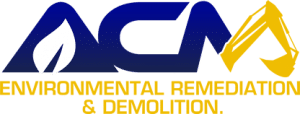Owning a commercial, industrial, or institutional building comes with federal and state regulations for demolition and renovation. Any improvements must meet compliance regulations under the National Emission Standards for Hazardous Air Pollutants (NESHAP) for asbestos.
A certified asbestos inspection and abatement expert will be well acquainted with the regulations and work practices your demolition or renovation project will be subject to and can help ensure compliance. Keep reading to learn more about the NESHAP, the compliance regulations under the Clean Air Act, and how they affect your demolition or renovation project.
What Do the National Emission Standards for Hazardous Air Pollutants (NESHAP) for Asbestos Require?
Federal regulatory requirements were enacted to protect public health and safety regarding asbestos-containing materials (ACM). The Clean Air Act (CAA) necessitated the Environmental Protection Agency (EPA) to develop and enforce these regulations. There are also state and local regulations that might also apply to the identification of ACM.
The National Emission Standards for Hazardous Air Pollutants (NESHAP) requires that any demolition subject to the asbestos NESHAP be thoroughly inspected for asbestos prior to demolition or renovations. The information provided in the inspection will allow the property owner to determine which of the requirements of the NESHAP for asbestos will apply to their renovation or demolition project.
The NESHAP for asbestos under the EPA is intended to minimize exposure to asbestos and the release of asbestos fibers during activities like demolition and renovation, which involve handling ACM.
Why is Asbestos Regulated by the NESHAP?
In section 112 of the Clean Air Act, the EPA established the National Emission Standards for Hazardous Air Pollutants (NESHAP). These standards specifically addressed the list of hazardous air pollutants or “air toxics” that threatened public health. The pollutants on the list are known or suspected to cause cancer or other serious health conditions.
Asbestos is regulated by the NESHAP because it is a known carcinogen associated with three major health issues: lung cancer, mesothelioma, and asbestosis. Asbestos was one of the first hazardous air pollutants added on March 31, 1971. On April 6, 1973, Asbestos NESHAP was formed and has been amended several times.
The regulations concerning asbestos-containing materials (ACM) are to be followed in specific circumstances laid out by the NESHAP. Asbestos inspections are to be performed by certified asbestos professionals that have undergone specific training to handle ACM.
Demolition and Renovation of Buildings
There are specific work practices laid out by the Clean Air Act to be followed during renovations and demolitions of all facilities, including installations, structures, and buildings, except for residential properties with four or fewer dwelling units. The regulation requires a thorough inspection and notification to the state agency or delegated entity prior to demolition or renovation. Finally, it requires all work safety standards to be implemented in the control of asbestos emissions.
Institutional, Industrial, and Commercial Buildings
Institutional, industrial, and commercial properties are subject to NESHAP regulations for demolition and renovation. At a minimum, those requirements apply to a thorough asbestos inspection of the property and notification of demolition or renovation to the appropriate entity.
Large-Scale Residential Demolition
The EPA amended the NESHAP for asbestos in 1990 to include residential structures that are renovated or demolished as part of a public or commercial project. The exemption was removed, and large-scale residential demolition was added to the type of buildings subject to NESHAP.
How is Asbestos NESHAP Involved in the Inspection Process?
Specific work practices must be followed when inspections or abatements are performed to mitigate the risk of asbestos exposure. These practices include the removal of all asbestos-containing materials, utilizing wet cleaning asbestos-containing materials, sealing contaminated materials in leak-tight containers, and properly disposing of the materials as asbestos-containing waste according to all practices and environmental regulations.
To ensure that these work practices are followed without deviation, Asbestos NESHAP requires at least one onsite representative trained in the means of compliance and regulatory provisions to be present for any demolition or renovation project. This representative must refresh their training every two years to ensure they are up-to-date on all compliance regulations and work practices.
Hiring a certified asbestos expert to perform your inspection will ensure that you are in compliance with these regulations and work practices. Should the results of the inspection return positive for asbestos on your property, our experts will provide next steps for abatement.
Why Choose the ACM Team for Asbestos Inspection Services
When you choose ACM, you can be assured our inspections are done with the most modern technology to guarantee precision and accuracy. We use crafted expertise and skills to conduct a comprehensive survey of your property for asbestos-containing material before we start with asbestos removal or management processes.
With the ACM Team, you can trust that our asbestos inspection experts are experienced professionals who will provide a personalized plan and safe process for removing hazardous materials from your property. With over 20 years of expertise in this industry, we guarantee satisfaction with every project. Contact us today at (603) 319-1270 to learn more about our services and how we can help you.














